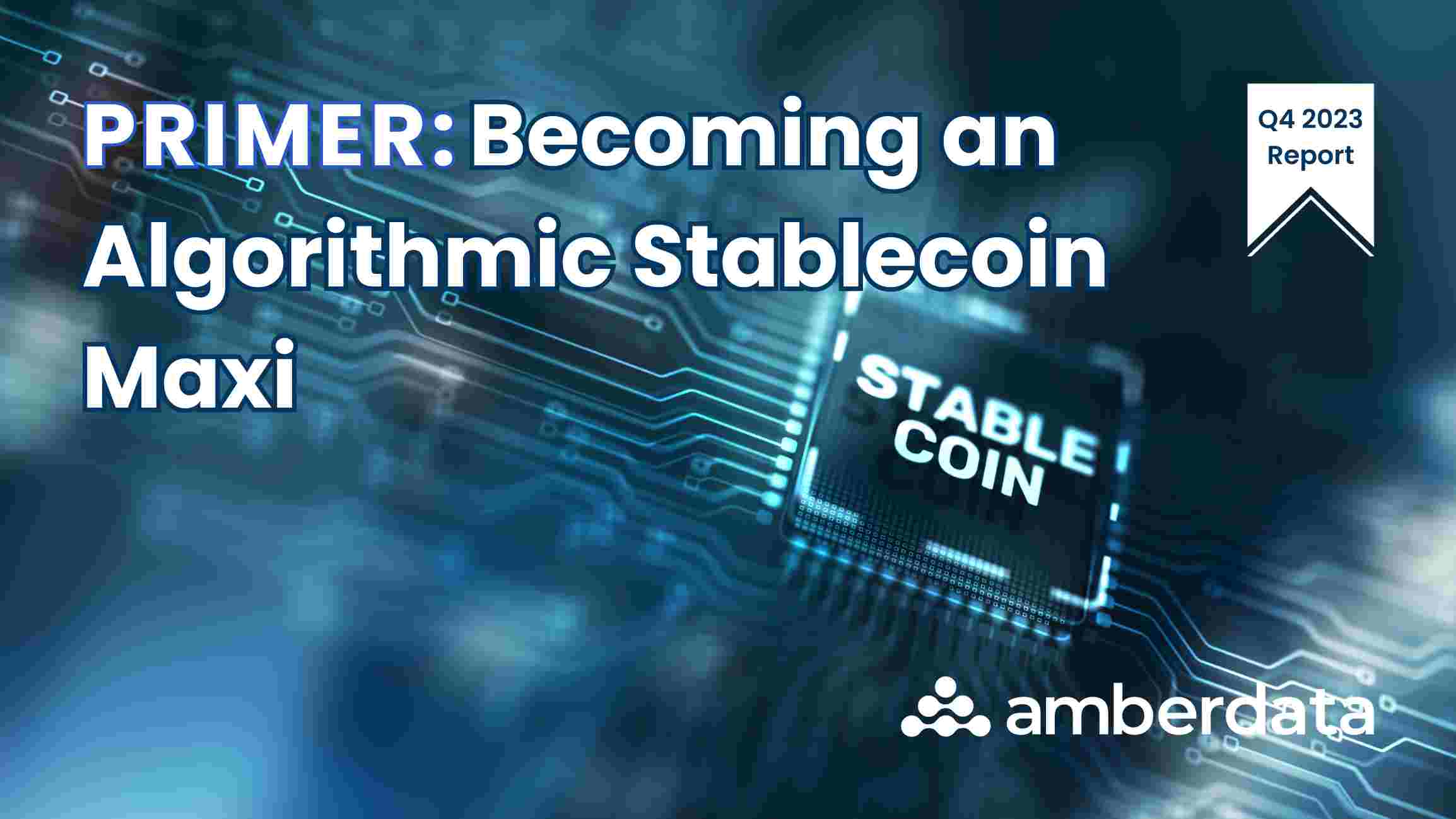
Stablecoins, designed to maintain a peg with a fiat currency, have become a key pillar of the crypto economy. From being used for remittances to providing safe havens during periods of high volatility, the total stablecoin supply on Ethereum has reached over $70 billion.
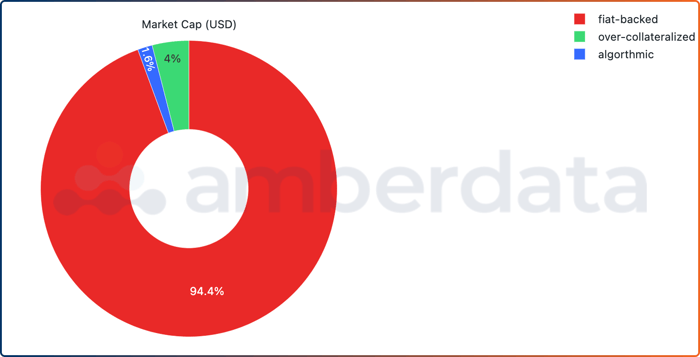
Market Cap dominance by stablecoin type as of August 30, 2023

Daily token holder dispersion (between October 2020 and August 30)
There are three main types of stablecoins:
- Fiat-backed stablecoins (or “fiat-collateralized” stablecoins): backed by fiat currencies, often a reserve or liquid collateral.
- Over-collateralized stablecoins (or “anchored” stablecoins): often backed by a basket of currencies, which may or may not include other stablecoins or cryptocurrencies.
- Algorithmic stablecoins (or “reflexive” stablecoins): governed by algorithm(s) that adjust the token’s supply based on demand. They may or may not be supported by collateral.
This primer focuses on algorithmic stablecoins. We will provide an overview of the biggest stablecoins, discuss their majorly defining moments, and closely examine what happens when tokens depeg.
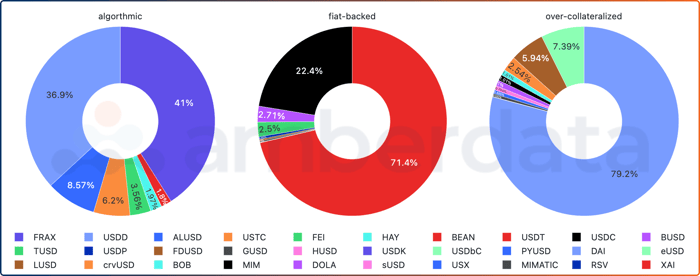
Market Cap dominance by stablecoin type (as of August 30, 2023).
In addition to how stablecoins are categorized, there are some other important characteristics to consider when evaluating these digital assets.
- Centralization and governance: Governance structures of stablecoins range from being a fully decentralized and unmanaged token to a single signer administrator. The governance structure can be a source of risk for many who prefer not to be involved with anonymous developers or overzealous compliance and legal teams.
- Audits and transparency: Transparency regarding backed assets (primarily for tokens with fiat backing and over-collateralized tokens) helps ensure that stablecoins are backed as claimed. A common form of transparency comes in the form of “attestations,” in which a declaration of evidence is provided. These attestations are sometimes validated by a third-party “opinion,” but attestations are often unsupported by any third party and should not always be taken at face value. An “audit” is much more valid, and proof of reserves (depending on the methodology) can be useful for risk mitigation. This is important to note: Attestations are not audits, and opinions do not qualify as independent audits, nor can they be considered completely independent.
- Regulatory considerations: Stablecoins, especially those backed by fiat currencies, can fall under regulatory scrutiny by various regulatory bodies underlying the fiat currency (or currencies) underlying the peg. Understanding the regulatory situation and the significance of any scrutiny helps users navigate available options and their levels of associated risk.
- Supported networks: As stablecoins grow in popularity and different use cases, launching on new chains has been another angle stablecoin issuers have used to grow their user base and market capture. However, this comes with its trade-offs, as each network has its nuances and some are more prone to unwanted exploits such as oracle exploits or network bugs. If building strategies that cross networks, users should know which networks a stablecoin is on.
- Supported exchanges: Not every exchange will support each stablecoin. There are competitive advantages to not supporting certain stablecoins, especially for those that compete with existing products. There was some shock and awe last year when Binance announced that they would remove support for three different stablecoins (USDC, USDP, and TUSD) by converting all stablecoins held on the exchange to their own BUSD. This plan did not fully form, as the exchange continued to support USDC and even recently integrated USDC deposits and withdrawals for the Arbitrum network (not to mention BUSD’s ongoing SEC case and recently announced termination of BUSD). In any case, exchanges have differing levels of liquidity for supported stablecoins, so users should keep in mind their preferred entry (on-ramp) and exit (off-ramp) points and plan accordingly. Transaction fees and slippage to convert funds between a liquid and illiquid pair can quickly turn a profitable strategy into a breaking one.
- Blacklist functionality: Blacklists give contract administrators the ability to freeze funds or prevent an address from transacting with a given token. Token blacklists are becoming popular as a way to prevent the movement of exploited funds by malicious actors. However, this function can be used in ways that do not always support the users’ philosophies, such as when Circle (issuer of USDC) blacklisted 45 Ethereum addresses after OFAC regulatory actions against Tornado Cash. Users should keep in mind the levers possessed by stablecoin issuers that may support or inconvenience their use case.
- Gasless transactions: Gasless transactions can be a convenient feature for users offering gas-free transactions, where on-chain gas fees are paid by a third party such as a payment provider or an exchange. However, these gasless transactions are not without risks: bad actors have accumulated over $68 million from this exploit on Ethereum alone. It is critical to never sign a transaction, even commonplace “Connect to” signatures, without understanding the implications. Many tokens and popular stablecoins have this feature built into their contract, so signing a malicious signature request can lead to a bad actor draining the entirety of a user’s wallet without them even realizing it happened.
- Peg stabilizing methods: Stablecoins can and often do move in price away from their peg. For example, USDT, a US dollar stablecoin, has been lower than its $1 peg for the last month after a Curve pool imbalance (the token has otherwise continued to operate normally). Mechanisms available to stablecoins for depeg mitigation vary widely from adjusting the supply to stablecoins, altering collateral, or implementing governance decisions. If mechanisms in place fail to perform or do not exist, the stablecoin may never return to its peg or the market.
Algorithmic Stablecoins
Overview

Market Cap dominance for algorithmic stablecoins as of August 30, 2023

Market Cap for algorithmic stablecoins as of August 30, 2023
Algorithmic stablecoins are pegged through algorithms and often have a “sister” token to help maintain their peg. As supply and demand determine the price of the token, arbitrageurs adjust the demand curve by buying a stablecoin for less than $1 and redeeming it for $1 worth of the sister token. This ecosystem has trade-offs, as evidenced by multiple algorithmic stablecoin collapses in recent years. Currently, FRAX and USDD dominate the algorithmic stablecoin space with a combined 78% of the market share.

Algorithmic stablecoin prices for select tokens from October 2020 to August 30, 2023.
Perhaps the largest trade-off for users of algorithmic stablecoin is price stability, which is more volatile than fiat-backed or over-collateralized stablecoins. Often, algorithmic token volatility is tied to its sister token, which can be used for governance or other use cases.
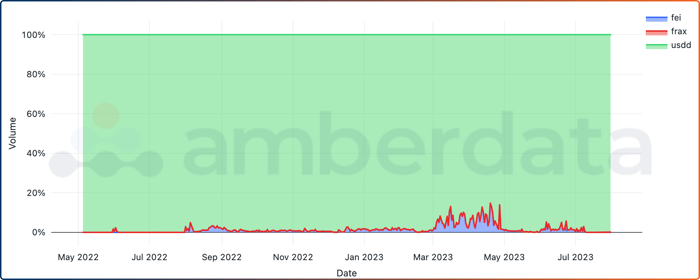
Spot trading volume market share for algorithmic stablecoin select tokens from October 2020 to August 30, 2023
Due to the push by Huobi on its platform, spot trading is dominated by USDD. These stablecoins have a considerable risk for centralized exchanges that prefer fiat-backed or over-collateralized tokens, so support for them is often smaller.
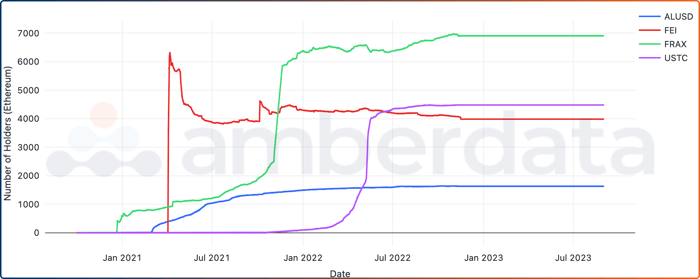
Daily number of holders for algorithmic stablecoins on select tokens from October 2020 to August 30, 2023

Daily holders dispersion of fiat-backed stablecoins on select tokens from October 2020 to August 30, 2023
The number of token holders on Ethereum has been relatively stable for algorithmic stablecoins. These tokens are more widely adopted on other networks, though holder counts are far from reaching the highs of fiat-backed tokens.
|
Symbol |
Name |
Supported Networks |
Blacklist |
Gasless |
|
UST/ USTC |
Terra/Terra Classic |
Ethereum, Solana, Avalanche, Phantom, Polygon, Harmony, BNB Chain, Moonriver |
❌ |
✅ |
|
FRAX |
Frax |
Ethereum, Solana, Avalanche, Phantom, Polygon, Optimism, Arbitrum, BNB Chain, Moonriver |
❌ |
✅ |
|
USDD |
Decentralized USD |
Ethereum, Tron, BNB Chain, Near |
Unclear |
Unclear |
|
FEI |
Fei USD |
Ethereum, HECO |
❌ |
✅ |
|
alUSD |
Alchemix USD |
Ethereum |
✅ |
✅ |
|
BEAN |
Bean |
Ethereum |
❌ |
✅ |
Algorithmic Stablecoins
Terra (UST)/Terra Classic (USTC)

USTC (UST) market cap since October 2020
In many ways, Terra (UST) was a case study for stablecoin success, but its legacy will always be a cautionary tale. Founded by CEO Do Kwon and co-founder Daniel Shin, the Terra network started development in January 2018, ICO’d in January 2019, and launched UST in September 2020.
Cyrus Younessi, an analyst and now Director of Research and Trading at Scalar Capital, famously wrote that the project was at risk of entering a “death spiral,” where LUNA, the sister token for UST and the network token for the Terra blockchain, could cause UST to de-peg and create a downward spiral for both tokens. Another famous example of a death spiral was Iron Finance’s IRON and TITAN tokens. which saw TVL over $1 billion and a CR lowered to mid-70% in just a few weeks.
Algorithmic stablecoins like UST are often paired with a sister token such as LUNA to help maintain its peg. In theory, the protocol would allow $1 worth of LUNA to be used as collateral to receive $1 UST, creating a stable peg. It would also allow arbitrageurs to mint more UST with the same amount of LUNA when UST was less than $1, or burn UST to receive LUNA when UST was over $1. However, as one token gets cheaper, more of it would be used to provide collateral for the stablecoin. At the most extreme, the stablecoin could become 100% backed by its sister token, and the peg would be completely lost.
In April 2022, Luna’s price rose from less than $1 in 2021 to all-time highs of $116, with Jump Crypto and Three Arrow Capitals being large investors and holders of the token. At this time, UST had quickly risen to become the third-highest stablecoin by market capitalization. Days later, several on-chain swaps of UST for USDC began to depeg the token, leading to a series of UST withdrawals on Anchor and Curve. Continuous pressure and fear around the peg caused another depeg just two days later, dropping the token to as low as $0.35 until May 12, when the price fell 96% in a single day to less than $0.10.
The collapse of Terra ended with this tweet by Do Kwon, who was also part of the pseudonymous team behind failed stablecoin Basis Cash:

The collapse of Terra/Luna caused a ripple effect felt around the entire crypto ecosystem. The UST and LUNA “Revival Plan'' was approved by Terra validators on May 25, 2022, with Do Kwon’s plan to launch a new blockchain (Terra 2.0) without a stablecoin and rename the existing Terra network (Terra 1.0), native token Luna (LUNA) to Luna Classic (LUNC), and Terra (UST) to Terra Classic (USTC).
Learn more about becoming an algorithmic stablecoin maxi as this is just a subset of the report. In the rest of the report, we go through many more stablecoins including Frax (FRAX), Decentralized USD (USDD), Fei USD (FEI), and a few more.
Download the complete research report here:
Amberdata
Amberdata is the leading provider of global financial infrastructure for digital assets. Our institutional-grade solutions deliver data, analytics and comprehensive tools and insights that empower financial institutions to research, trade, and manage risk and compliance in digital assets. Amberdata serves as a...
